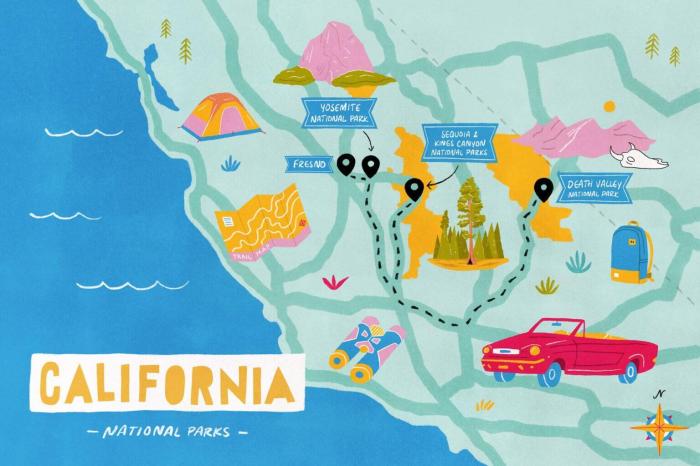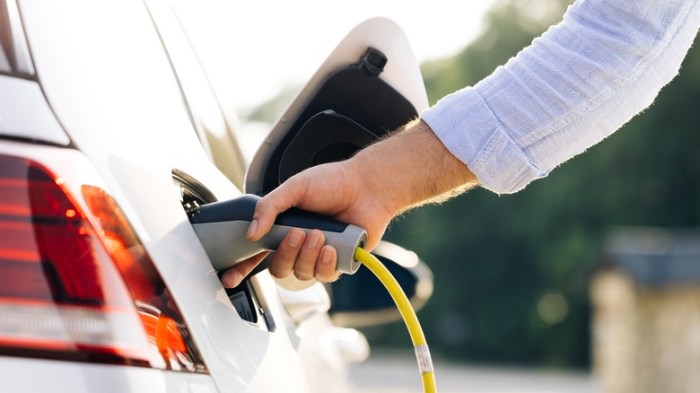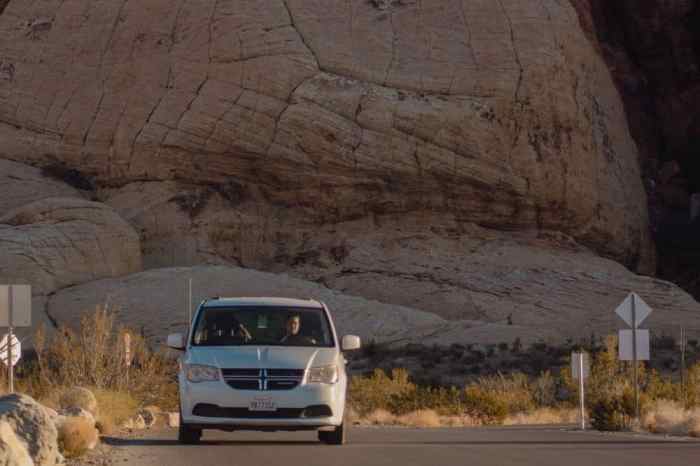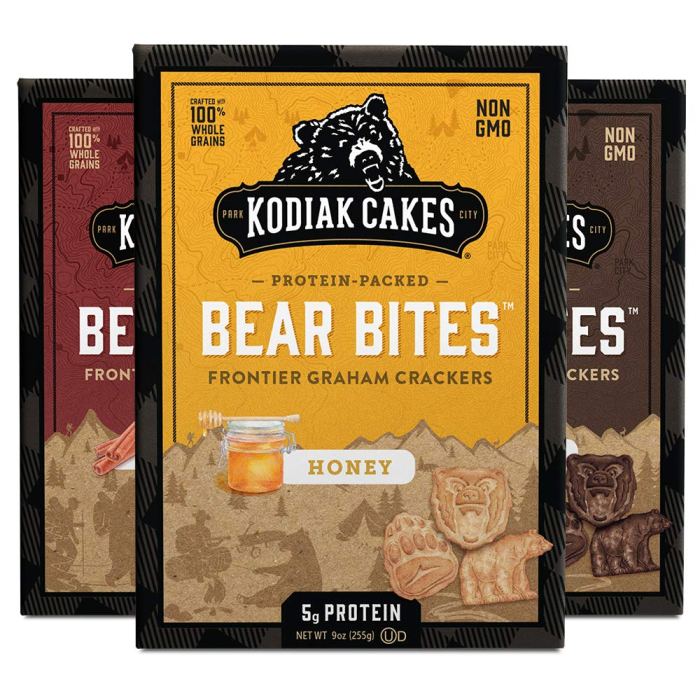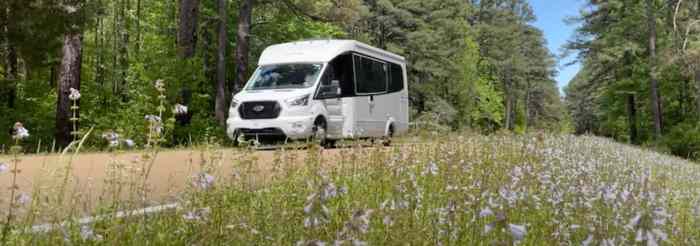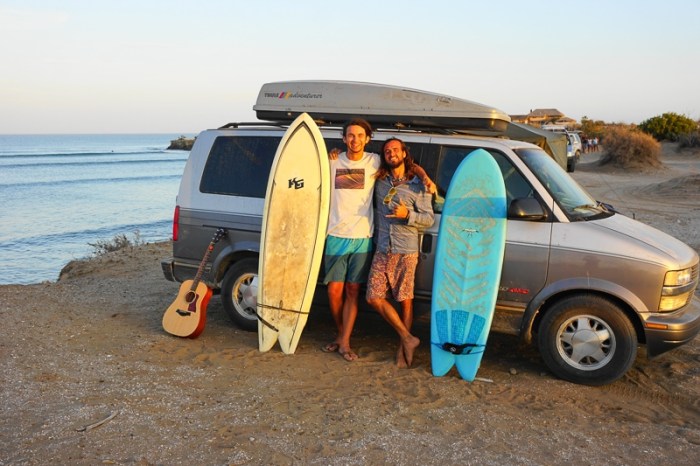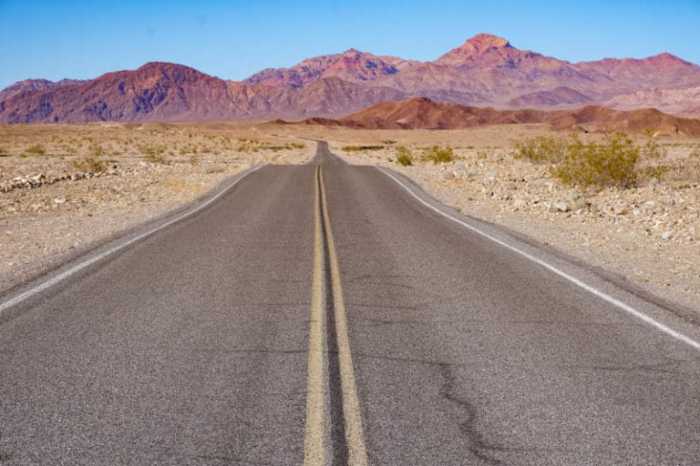California national parks road trip: Prepare for an unforgettable journey through breathtaking landscapes and iconic parks. This comprehensive guide covers everything from detailed itineraries and budgets to essential packing lists and safety tips, ensuring your adventure is seamless and unforgettable. Get ready to immerse yourself in nature’s grandeur, from hiking trails to scenic overlooks, and discover hidden gems beyond the typical tourist spots.
This guide provides a roadmap to planning your epic California national parks road trip. We’ll explore various accommodation options, activities, essential information, food and drink recommendations, wildlife encounters, and tips for a smooth trip, ensuring you make the most of your time exploring the Golden State’s natural wonders.
Planning the Trip
California’s national parks offer a breathtaking journey through diverse landscapes. Planning a road trip allows for flexibility and immersion in these natural wonders. This section details a potential itinerary, budget, packing list, and route map for a memorable 10-day and 2-week adventure.
10-Day California National Parks Itinerary
This itinerary focuses on a 10-day journey, offering a balance of iconic parks and manageable travel time.
- Days 1-3: Yosemite National Park. Explore iconic granite cliffs, towering waterfalls, and giant sequoias. Hike to Yosemite Valley, admire El Capitan and Half Dome, and enjoy the park’s diverse flora and fauna. Consider a guided tour for a deeper understanding of the park’s history and geology.
- Days 4-5: Sequoia & Kings Canyon National Parks. Witness the awe-inspiring General Sherman Tree, the largest tree by volume on Earth. Hike among giant sequoias, and explore the diverse landscapes of Kings Canyon, known for its deep canyons and granite peaks.
- Days 6-7: Death Valley National Park. Experience the extreme beauty of Death Valley, from its shimmering salt flats to its dramatic mountain ranges. Visit Zabriskie Point, Badwater Basin, and Dante’s View. Pack plenty of water and be prepared for high temperatures, especially during the summer months.
- Days 8-9: Joshua Tree National Park. Discover the unique desert landscape of Joshua Tree National Park, known for its unusual rock formations and diverse plant life. Hike among the iconic Joshua trees, and enjoy scenic drives through the park’s many trails. Consider stargazing, as the park offers excellent dark skies.
- Day 10: Departure. Enjoy a final breakfast amidst the California scenery before driving to your departure point, reflecting on the incredible journey.
2-Week California National Parks Itinerary (Detailed Route Map)
This extended itinerary explores a broader range of California’s parks, emphasizing scenic routes and viewpoints.
This route would require more time, enabling a more relaxed exploration. A two-week trip allows for a more detailed experience of each park, including optional side trips to nearby attractions.
| Day | Location | Activities | Notes |
|---|---|---|---|
| 1-3 | Yosemite National Park | Valley floor hikes, waterfall viewing, iconic views | Consider lodging options inside the park |
| 4-6 | Sequoia & Kings Canyon National Parks | Giant Sequoia groves, Kings Canyon’s deep canyons | Allow ample time for hiking and exploring |
| 7-8 | Death Valley National Park | Badwater Basin, Zabriskie Point, Dante’s View | Be prepared for extreme temperatures |
| 9-11 | Channel Islands National Park | Island exploration by boat, wildlife viewing | Ferry or boat access is required |
| 12-14 | Pinnacles National Park | Hiking, rock climbing, exploring the unique rock formations | A less crowded option compared to some parks |
| 15 | Departure | Travel to your next destination |
Sample Budget
A realistic budget considers accommodation, food, entrance fees, and gas. Prices vary based on season, lodging choices, and meal preferences.
- Accommodation (Camping/Hotels): $150-$500 per night
- Food: $50-$100 per day (depending on dining choices)
- Park Entrance Fees: $35-$80 per park (per vehicle)
- Gas: $50-$150 per day (depending on mileage and gas prices)
Essential Packing List
This list categorizes items for different activities to ensure you’re prepared for diverse conditions.
- Camping: Tent, sleeping bags, camp stove, cooking utensils, cooler, food, water bottles, sunscreen, insect repellent, first-aid kit
- Hiking: Hiking boots, comfortable clothing, water bottles, snacks, layers of clothing, rain gear, compass or GPS, map
- General: Camera, binoculars, reusable water bottles, chargers, toiletries, first-aid kit, hat, sunglasses
Accommodation Options
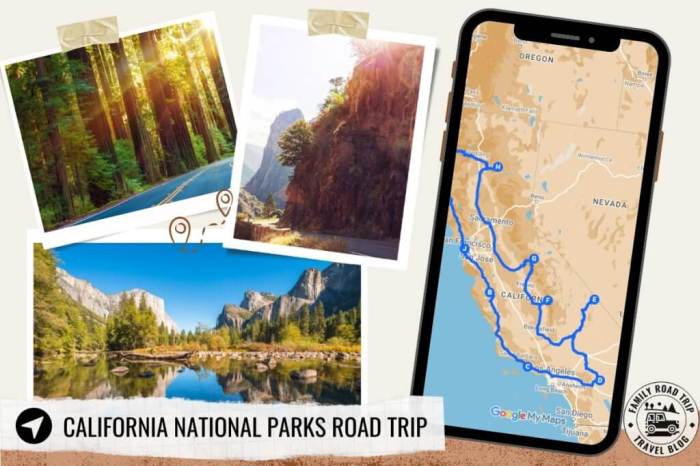
Choosing accommodation is crucial for a smooth California national park road trip. The right lodging ensures you’re rested and ready to explore each park’s wonders. From budget-friendly campgrounds to luxurious hotels, the variety of options caters to diverse needs and preferences. Knowing the pros and cons of each type, coupled with effective booking strategies, is key to maximizing your trip experience.California national parks offer a diverse range of accommodation options, catering to different budgets and preferences.
This section details the available choices, comparing their features, and outlining the booking process to help you plan effectively.
Campgrounds
Campgrounds provide a quintessential camping experience, immersing you in nature’s embrace. They often offer stunning views and the opportunity for outdoor activities like hiking and stargazing. However, reservations are essential, especially during peak seasons. Reservations can be challenging to secure, requiring careful planning and flexibility.
- Pros: Budget-friendly, immerse you in nature, offer opportunities for outdoor activities like hiking, and provide close proximity to park amenities.
- Cons: Reservations are often needed and can be challenging to secure. Amenities might be basic compared to hotels or vacation rentals.
Hotels and Motels
Hotels and motels provide convenience and amenities, including comfortable rooms, restaurants, and potentially pools. They offer a degree of comfort and proximity to park entrances, making them a viable alternative to camping. However, they often come with higher costs.
- Pros: Convenience, often include amenities like restaurants and pools, and can provide close proximity to park entrances.
- Cons: Usually more expensive than campgrounds, and the experience might not be as immersive as camping.
Vacation Rentals
Vacation rentals offer a unique alternative, providing more space and privacy than hotels. These rentals might be houses, cabins, or apartments, often situated in towns near the parks. They allow for a home-away-from-home experience, but might not always be conveniently located.
- Pros: More space and privacy than hotels, often offer kitchen facilities, and may provide a home-away-from-home feel.
- Cons: Can be more expensive than hotels, and might not always be in close proximity to the park entrance.
Booking Process and Strategies
Securing reservations, especially for campsites, is crucial for a successful road trip. National Park Service websites often require advance booking, often weeks or months in advance, for popular campsites. Using the park’s official reservation system and setting reminders are key to securing your desired accommodations.
- Strategies: Utilize the park’s official reservation system, set reminders for booking deadlines, and be prepared to book during off-peak hours if necessary.
- Tips: Check the availability of various accommodation types, and consider the pros and cons of each based on your trip budget and preferences.
Popular Options near California National Parks
Various options exist within a 50-mile radius of California national parks, ranging from campgrounds to hotels and vacation rentals. Specific options vary greatly based on the particular park. For example, Yosemite National Park has numerous campgrounds and hotels in close proximity, while smaller parks might have fewer choices. Research specific locations and compare options for your preferred park.
| Park | Popular Accommodation Types |
|---|---|
| Yosemite National Park | Campgrounds, hotels, and vacation rentals |
| Sequoia & Kings Canyon National Parks | Campgrounds, hotels, and vacation rentals |
| Death Valley National Park | Campgrounds, hotels, and limited vacation rentals |
Activities and Experiences
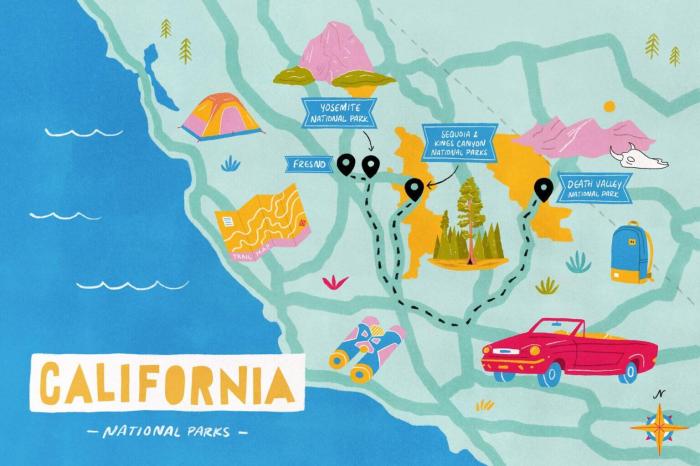
California’s national parks offer a wealth of experiences, from thrilling hikes to serene wildlife encounters. Beyond the iconic vistas, hidden gems and unique perspectives await those willing to venture off the well-trodden paths. This section explores popular and lesser-known activities, highlighting the best times to visit for optimal enjoyment.Exploring California’s national parks is more than just seeing the sights; it’s about immersing yourself in the natural world and discovering hidden treasures.
This guide provides insights into diverse activities, from challenging hikes to tranquil scenic drives, and reveals the best times to visit, considering weather, crowds, and wildlife behavior.
Popular Activities
California’s national parks draw millions of visitors annually, and for good reason. Hiking is a cornerstone experience, with trails ranging from gentle strolls to strenuous climbs. Wildlife viewing, whether spotting deer grazing in meadows or observing majestic eagles soaring overhead, is another key attraction. Scenic drives, winding through valleys and along breathtaking coastlines, offer unparalleled opportunities to capture the park’s beauty.
Just finished an amazing California national parks road trip, soaking up the sun and stunning scenery. While I was dreaming of snowy peaks, I stumbled across some amazing deals for a Mount Baker Washington ski trip, specifically the mount baker washington ski trip mountain mondays package. Now, back on the California national parks road trip train, I’m already planning my next adventure, fueled by the memories of the stunning vistas.
Less-Known Activities and Attractions
Beyond the popular hotspots, California’s national parks offer hidden gems. Consider ranger-led programs, which often delve into the park’s history and ecology. Photography enthusiasts will find endless opportunities to capture unique perspectives and landscapes. Some parks feature historical sites or museums that offer deeper cultural insight. Exploring these less-visited aspects provides a more enriching experience.
Must-See Viewpoints and Scenic Drives
California’s national parks boast stunning viewpoints and memorable drives. A quintessential example is the iconic vista point at Yosemite Valley, offering a panoramic view of El Capitan and Half Dome. The winding roads of the Pacific Coast Highway, especially within Big Sur, provide stunning ocean vistas and dramatic coastal cliffs. The scenic drive through the Grand Canyon, if included in your itinerary, offers unparalleled views of the canyon’s grandeur.
These locations, though popular, deserve a spot on your itinerary due to their unparalleled beauty.
- Yosemite Valley Viewpoint: Offers a breathtaking vista of iconic granite monoliths like El Capitan and Half Dome. The sheer scale of the valley is awe-inspiring.
- Big Sur Coastline: The Pacific Coast Highway in Big Sur provides a scenic drive along dramatic cliffs, towering redwoods, and breathtaking ocean vistas. The changing light throughout the day adds to the magic.
- Grand Canyon South Rim Drive: A must-do for those visiting the Grand Canyon, offering varied viewpoints and opportunities to experience the canyon’s vastness. The vast scale and deep canyons are unforgettable.
Best Times to Visit
California’s national parks offer diverse experiences depending on the season. Spring often brings wildflowers blooming, attracting both visitors and wildlife. Summer offers warm weather but can lead to larger crowds. Autumn brings vibrant foliage, while winter offers a tranquil atmosphere with fewer crowds but potentially inclement weather. Choosing the best time depends on your tolerance for crowds and your preference for weather conditions.
| Season | Weather | Crowds | Wildlife |
|---|---|---|---|
| Spring | Pleasant temperatures, wildflowers blooming | Moderate | Active breeding season |
| Summer | Warm temperatures, potential for heat waves | High | Animals may be more active |
| Autumn | Pleasant temperatures, colorful foliage | Moderate | Wildlife may be more visible |
| Winter | Cool temperatures, potential for snow | Low | Animals may be less active |
Essential Information
California’s national parks offer breathtaking landscapes and unique experiences. However, responsible tourism requires understanding the rules and regulations to protect these natural wonders. This section details essential information for a smooth and respectful visit.
Park Rules and Regulations
California national parks have specific rules and regulations to maintain the natural environment and visitor safety. These guidelines vary by park but generally include restrictions on activities like camping, hiking, and driving. It’s crucial to review the park’s specific regulations before your visit, as some parks have specific requirements for permits or reservations. Failure to comply with these regulations can result in fines or other penalties.
Familiarize yourself with the park’s designated trails, closures, and any necessary permits or reservations well in advance of your trip.
Permits and Reservations
Many California national parks require permits or reservations, especially for camping and popular activities. These are essential for ensuring the park’s resources are managed effectively. For example, Yosemite National Park requires reservations for campsites well in advance, particularly during peak season. Make sure to check the park’s official website for specific permit requirements and reservation systems.
Visitor Guidelines
Respecting the environment and other visitors is crucial for a positive experience in California’s national parks. These parks are home to diverse ecosystems and wildlife. Leave no trace, pack out everything you pack in, and maintain a safe distance from animals. Be mindful of park regulations and follow guidelines to protect the natural environment and other visitors.
Emergency Contacts and Resources
Knowing emergency contacts and resources is essential for any outdoor trip. California national parks have emergency services, but it’s vital to be prepared. Having a detailed map of the area, knowing the nearest ranger station or emergency contact numbers, and carrying a fully charged mobile device can be life-saving. It is important to note that cell service can be spotty in some areas, so having a backup communication method is recommended.
Be prepared for potential issues and have a plan in place to address them.
Transportation Options
California national parks offer various transportation options. Shuttle services are commonly available to transport visitors within larger parks, providing an eco-friendly way to navigate. Ferry services are often used to access islands or remote areas within the parks. Public transportation may be available for reaching the park entrance. Using these options is often the most efficient and environmentally friendly way to move around the park.
My California national parks road trip was amazing, but I’ve been fascinated lately by the sustainable food scene in Norway, particularly the female farmers in Trondheim. Their innovative approaches to farming, detailed in this article about the trondheim norway female farmers sustainable food scene , are inspiring. Hopefully, I can incorporate some of those ideas into my future travels and maybe even into my own camping gear for my next California national parks adventure.
Park Comparison
| Park Name | Size (approx.) | Accessibility | Key Attractions |
|---|---|---|---|
| Yosemite National Park | 1,171 square miles | Relatively easy access, but some areas require reservations | Giant sequoias, Yosemite Valley, waterfalls |
| Sequoia & Kings Canyon National Parks | 1,500 square miles | Good access, but some trails can be challenging | Giant sequoias, granite cliffs, canyons |
| Death Valley National Park | 3,000 square miles | Varied accessibility, some areas extremely remote | Extreme desert landscape, unique geology, hot spring |
| Channel Islands National Park | 1,500 square miles | Ferry access required to most islands | Diverse marine life, unique island ecosystems |
This table provides a general overview of the different California national parks. Each park has its unique features and requires different approaches to transportation and exploration. Consider the specific needs and attractions when planning your trip.
Food and Drink
California’s national parks offer a diverse culinary landscape, reflecting the region’s vibrant food culture. From farm-to-table restaurants to casual cafes and local markets, there’s a satisfying meal waiting around every corner. Enjoying regional specialties is an integral part of experiencing the unique character of each park. Fueling your adventures with delicious food is essential for a memorable road trip.This section delves into the various food options available near California national parks, highlighting restaurants, cafes, and local markets.
It also provides practical tips for packing snacks and drinks for your outdoor adventures, as well as a helpful guide to local eateries.
Food Options Near California National Parks
A wide array of culinary experiences await visitors near California’s national parks. Restaurants, cafes, and local markets offer a spectrum of options, from casual eateries to fine dining establishments. These establishments reflect the region’s diverse agricultural heritage and commitment to fresh, local ingredients.
Local Eateries with Regional Specialties
Many restaurants near California’s national parks specialize in regional cuisine. These establishments offer unique culinary experiences that allow visitors to savor the flavors of the area.
- Yosemite National Park: Many restaurants offer Californian cuisine, highlighting fresh produce and locally sourced meats. Expect to find options like grilled salmon, roasted vegetables, and hearty salads. Some establishments feature Californian-style pizza and pasta dishes.
- Sequoia & Kings Canyon National Parks: Expect to find hearty, comfort-food options like BBQ, burgers, and sandwiches, reflecting the rustic atmosphere of the region. Some restaurants may feature wild game dishes, especially during hunting season.
- Joshua Tree National Park: Expect to find casual eateries and cafes with menus showcasing Southwestern cuisine. Expect tacos, burritos, and other Mexican-inspired dishes. Look for restaurants using locally sourced ingredients like cactus and other desert-grown produce.
Packing Snacks and Drinks for Outdoor Adventures, California national parks road trip
Properly packing snacks and drinks is crucial for enjoyable outdoor adventures within California’s national parks. Consider the length of your hikes and the expected weather conditions when making your choices.
- Non-perishable snacks: Trail mix, granola bars, energy bars, dried fruit, nuts, and crackers are excellent choices for energy boosts.
- Hydration: Bring plenty of water, sports drinks, or electrolyte solutions. Water bottles with insulated sleeves are highly recommended for keeping drinks cold.
- Cold Packs: Consider packing reusable cold packs to keep perishable items like sandwiches or yogurt cool for longer periods.
Local Food Trucks and Restaurants
A table below highlights some local food trucks and restaurants near various California national parks, providing a glimpse into the diverse culinary offerings.
| Park Name | Food Truck Name | Cuisine Type | Menu Highlights |
|---|---|---|---|
| Yosemite National Park | The Hungry Bear | American | Burgers, sandwiches, salads, and local craft beers. |
| Sequoia & Kings Canyon National Parks | The Redwood Grill | California | Grilled meats, fresh salads, and seasonal fruits. |
| Joshua Tree National Park | Desert Taco | Mexican | Tacos, burritos, quesadillas, and fresh juices. |
Wildlife Encounters
California’s national parks are teeming with incredible wildlife. From majestic bears to elusive mountain lions, encountering these creatures is a highlight of any visit. Respect for these animals and their habitats is paramount to ensuring a safe and enjoyable experience for everyone. This section details the wildlife you might encounter, their behaviors, and crucial safety guidelines to follow.California’s diverse ecosystems support a rich tapestry of wildlife.
Understanding their habits and behaviors is key to appreciating and respecting these magnificent creatures in their natural environments. Safety should always be a priority, and following the guidelines Artikeld here can help you enjoy these encounters without putting yourself or the animals at risk.
Common Wildlife Species
California’s national parks boast a remarkable variety of wildlife. Understanding the species you might encounter is crucial for a safe and responsible visit. The following list provides an overview of the common animals and the habitats they inhabit.
- Mammals: Bears, mountain lions, deer, raccoons, and various species of squirrels and rodents are commonly seen. Their behaviors vary depending on the species and the specific park. Bears, for example, are generally shy but can become aggressive if they feel threatened. Deer are often seen grazing in meadows and along park roads, exhibiting a generally docile demeanor.
Mountain lions are more elusive and usually avoid human contact, but vigilance is essential.
- Birds: From raptors soaring through the skies to songbirds flitting through the trees, diverse avian species are a constant presence. These include eagles, hawks, owls, and numerous songbird species. Observing their behaviors, like nesting or hunting, provides insight into their intricate lives. Knowing the type of bird and its natural behavior can assist in safe viewing.
- Reptiles and Amphibians: Snakes, lizards, and amphibians inhabit various park environments. They play crucial roles in the park’s ecosystem. Understanding their behaviors, including how they move and react to the environment, is essential for a safe encounter. It’s vital to avoid approaching them directly.
Safety Guidelines
Maintaining a safe distance from wildlife is crucial for both your safety and the animals’ well-being. Never approach or feed wildlife. Keep a safe distance, at least 100 feet from bears and other large animals. Be mindful of your surroundings and look out for any signs of animal activity. Always store food properly and keep it away from your campsite.
Planning a California national parks road trip is amazing, but sometimes you need a break from nature’s grandeur. I’ve been fascinated by the cinematic depictions of London, especially in films like those featured in lights camera london the big smoke on the big screen. Hopefully, after some city exploration, I can refocus and enjoy the stunning scenery of California’s national parks even more.
Never leave food unattended.
“Respect the animals’ space, and they will respect yours.”
Park Ranger Role
Park rangers play a vital role in managing wildlife encounters and educating visitors. They are trained professionals who understand wildlife behavior and can provide valuable insights. They can answer your questions, give safety advice, and provide information about the animals you encounter. They are an invaluable resource for a safe and informative experience.
Wildlife Encounter Table
| Park Name | Species | Habitat | Behavior |
|---|---|---|---|
| Yosemite National Park | Black Bear | Forests, meadows, near water sources | Generally shy but can become aggressive if threatened; often active during dawn and dusk |
| Yosemite National Park | Deer | Meadows, forests | Generally docile; often graze in open areas |
| Yosemite National Park | Bald Eagle | Forests, rivers, lakes | Soaring high above; hunting fish or small animals |
| Sequoia & Kings Canyon National Parks | Black Bear | Forests, meadows, near water sources | Generally shy but can become aggressive if threatened; often active during dawn and dusk |
| Sequoia & Kings Canyon National Parks | Mountain Lion | Forests, mountains | Elusive and avoids human contact; usually active at dawn and dusk |
| Channel Islands National Park | Sea Lions | Coastal areas, beaches | Playful and vocal; often seen basking on rocks |
Tips for a Smooth Trip
Embarking on a California national parks road trip is a thrilling adventure, but meticulous planning is key to a smooth journey. Anticipating potential challenges and preparing accordingly will transform your trip from a possibility to a reality. This section provides crucial strategies for navigating the diverse landscapes and ensuring a memorable experience.
Weather Contingency Planning
California’s diverse terrain and unpredictable weather patterns demand proactive planning. Understanding the potential for sudden shifts in temperature, rainfall, or even extreme heat is paramount. Pack layers of clothing to adapt to changing conditions. Having a backup plan for rain gear and appropriate footwear is essential for navigating potential inclement weather. For example, if you plan a hike in the mountains, prepare for possible snow or cold temperatures even during summer.
Emergency Preparedness
Road trips, especially in remote areas, require robust emergency preparedness. Knowing how to react to unexpected situations is crucial. A well-stocked emergency kit with essential supplies, including first-aid materials, a flashlight, extra batteries, and a portable charger, is a must. Understanding local emergency services contact numbers and routes to the nearest hospital or clinic will greatly enhance your preparedness.
Carrying a fully charged mobile phone with a reliable signal booster is highly recommended, particularly in areas with limited cellular reception.
Essential Documents and Items Checklist
A comprehensive checklist of essential documents and items will streamline your travel experience. This includes your driver’s license, vehicle registration, insurance documents, and park passes. Ensure your vehicle is in optimal condition, with adequate fuel, oil, and coolant levels. Essential items to include in your vehicle are a map or GPS navigation device, a portable charger, a first-aid kit, a water bottle, and snacks.
Consider packing a small toolkit for basic repairs.
Navigation within National Parks
Navigating California’s national parks efficiently requires a thoughtful approach. Using both maps and GPS systems will enhance your ability to explore the vast terrain effectively. Download offline maps of the park areas to avoid relying on unreliable internet connections. Understanding park regulations regarding parking, hiking trails, and campgrounds will help you plan your itinerary effectively. Utilize the park’s official website or visitor centers for up-to-date trail information and potential closures.
End of Discussion: California National Parks Road Trip
In conclusion, this guide provides a well-rounded overview of planning a California national parks road trip, covering essential aspects from itineraries and budgets to safety guidelines. With detailed information, you’re well-equipped to embark on an unforgettable adventure, immersing yourself in the beauty and diversity of California’s national parks. Remember to research specific parks and tailor the information to your interests and time constraints.
Have a fantastic road trip!
